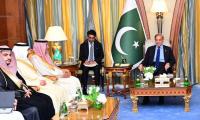The unprecedented Covid-19 has played havoc with human lives across the globe in the past five months.
Over a quarter of million people have lost their lives while more than four million are infected with the novel virus. The virus outbreak has brought social, cultural and commercial life to a standstill. It is only media and politics that are active.
In times of severe crises and emergencies, most countries and their people ignore their political differences and forge unity to face their common enemy, in this case an enemy which beyond any doubt poses an existential threat to our civilization.
Scientists, medical experts and public health scholars all are in deep-dive mode to search for solutions, how to buy time till a preventive vaccine is developed and produced. Meanwhile, business people and the ruling elite have shown great discomfort and anxiety over the closure of businesses and commercial activity.
In March and April when the virus spread to Europe, Iran, South Korea, it sent panic and shockwaves to all parts of the world. Political governments and opposition parties were in near consensus over placing restrictions on social mobility or what is commonly known as a ‘lockdown’. There was hardly much disagreement over lockdowns except in Pakistan. It was a testing time and remains so and our mainstream parties along with sections of the media are in constant arguments over the pros and cons of a lockdown in the country.
Pakistan went through the shortest lockdown period in the wake of a pandemic. Blaming economic hardship, the federal government kept pushing provinces to reopen their economies at earliest. In other federal states like Germany and the US, the decision and duration of lockdown remained with states; their federal governments passed on the guidelines, prepared by scientists, during the lockdown and for reopening.
Sadly, Pakistani people heard but little from infectious disease specialists; on pure subjects of medical science our people were made to listen and believe either politicians or religious preachers; in a nutshell, this was and remains our response to this fatal virus.
The Pakistani leadership had a window of opportunity to foresee what was coming from China, the Iranian border, international trips. But they paid no heed; there was no sense of urgency, not till we were already in mid-March and April. We did not procure enough personal protection equipment (PPE), ventilators etc. Based on studies in China, England and the US, this novel virus is not only damaging lungs but kidneys and the heart too; two reported deaths in New York and in Karachi the same week were because of absence of dialysis machines.
Pakistan’s so-called smart lockdown proved to be more lip-service as businesses, markets are all open and crowds of people can be seen on the streets. Pakistan’s decision to be back to business-as-usual was without any logical reasoning, unmatched anywhere. For eg, China’s phased opening was conditioned with a 14-day continuous decline in new cases and hospitalization rate.
We have not yet seen an analysis of the 0.3 million people tested in Pakistan in the past five months, except how many have died. When testing is so limited how can one have a big picture of the nature and scale of the disease, infected people, source, spread and contact tracing. Five months into the pandemic, we still do not know the ratio of infected people without symptoms or the hospitalization rate and how deep the spread has become.
In Sindh on May 14, some 4,000 people were tested, and 17 percent people tested positive. This is far more than America’s worst hit city of New York, where the death rate may be higher but the infection ratio was less than Sindh as per the tests in reference. Reopening should have been delayed for four to eight weeks with an aim to expand testing. Testing is the key to having sufficient data to plan a response. Our curve of cases has not flattened; others fear a possible second wave, but we aren’t even over the first one. The US has experienced three revised projections of possible deaths and cases; we did not have at all.
Knowing the poverty levels in our country, people abroad and inside the country started helping the needy on their own. While there are 36 million unemployed people in the US, we saw scores of Pakistani diaspora organizations launching donation campaigns to help people in Pakistan. Pakistan’s federal government’s Rs12,000 one-time cash assistance lacked planning, and it clearly seemed it went to people who were already in the Benazir Income Support Program (BISP); the cash assistance did not reach to the ones who lost their jobs because of weeks long lockdown.
The pandemic is not over. With limited testing capacity we already have seen a surge in cases and reported deaths; 38,437 cases and 822 deaths by mid May seem only a prelude to the worse that is yet to come. Imagine our small town hospitals, where one would not find ventilators and other equipment; there even 500 cases would create chaos.
Our lack of action shows that our policy solely relies on herd immunity, which actually has been rejected by the World Health Organization. The pain and suffering that Britain, France, Italy, Spain, Germany, the United States and now Russia have seen, where the number of deaths among medics is unparalleled, show that we have not learnt anything. Pakistan’s policymakers have shown utter inability to grasp the power of this disease.
“I wonder how many people have died not necessarily because of the virus but because this country failed them and left them to fend for themselves. That is the grief for me now, that is the guilt and the rage”. Did Mara Gay say this for us?
Email: mush.rajpar@gmail.com
Twitter @mushrajpar
In this picture taken on April 16, 2023, people throng a market area during shopping in Lahore. — AFPCare to cast...
A representational image of a transmission tower, also known as an electricity pylon. — AFP/FileLower electricity...
Pakistan's third Governor General Ghulam Muhammad. — National Portrait Gallery website/FileAs discussed in the...
This image shows Karachi Police personnel and commandos standing guard on November 29, 2023. — Facebook/Karachi...
Earth Day protests carry a vital message that is relevant 365 days a year. — AFP File Earth Day is celebrated every...
People walk along a market in Lahore on May 17, 2023. — AFP/FileMany of us had hoped that the general election...







